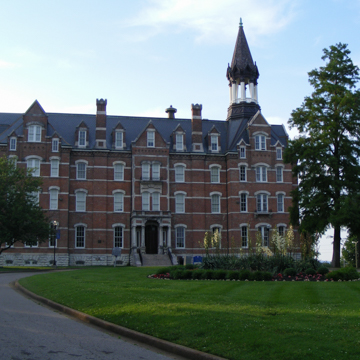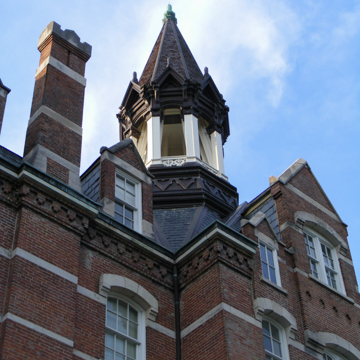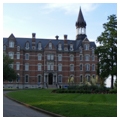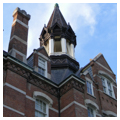Jubilee Hall is located on the campus of Fisk University, a private co-educational and historically black university in North Nashville. The Victorian Gothic Revival building with its Chateauesque, Gothic, and Renaissance detailing, is one of the centerpieces of the campus. The six-story, L-shaped, brick building with stone elements was built to be a dormitory with a dining area, parlors, and offices. Erected between 1873 and 1876, it was designed by New York architect Stephen D. Hatch, with construction superintendent Thomas C. Steward greatly involved in the final appearance of the building.
Called “modern English” by the American Missionary in 1873, the facade of Jubilee Hall presents a symmetrical design with the exception of the tall tower, with its octagonal base and conical cupola, that sits at the southeast ridgeline. The cupola is embellished with metal details including small pediments, a finial, trefoils, and leaves, all of which are supported by stylized columns. Patterned slate and corbelled brick below the eaves add to the architectural character of the building. Entry to the building is through tall, double-leaf, wood-paneled doors that have molded trim. Paired stone Roman Doric columns on paneled bases and a stone shouldered architrave surround the principal entry. Above this are paired windows with “Jubilee 1873 Hall” incised in a stone tablet. The stone embellishments are also seen in the segmental arched windows with keystones and label moldings. Stone bands at the window arches and window sills contrast with the red brick of the building.
Fisk was founded in 1866 and became a university the next year. The American Missionary Association of New York City, the Western Freedmen’s Aid Commission of Cincinnati, and General Clinton Fisk—after whom the school was named—of the Tennessee Freedmen’s Bureau, were instrumental in founding the school. Reverend E.P. Smith of the American Missionary Association and E.M. Cravath of the Middle West Department of the Association bought the property on which the school was built. Classes were initially held in former Civil War hospital barracks.
Jubilee Hall was named in honor of the Jubilee Singers, a group of five female and four male students who toured the U.S. in 1871, and soon thereafter toured Europe and Great Britain to raise money for a campus building. The group, led by Fisk music teacher Reverend George L. White, raised $150,000. The funds allowed the university to construct Jubilee Hall, the first permanent building on the campus.
The charter for the school stated that it was to be for “the education and training of young men and women irrespective of color.” Ensuing state legislation called for only African Americans to be educated at the school. The 1965 Higher Education Act established the Historically Black Colleges and Universities under Title III; Fisk University is one of approximately 100 such institutions. In addition to Jubilee Hall, the university has several other historic buildings on the campus.
References
Historic American Buildings Survey. “Fisk University, Jubilee Hall.” Library of Congress Prints and Photographs Online Catalog.
Looney, Percy, and Berle Pilsk, “Fisk University Historic District,” Davidson County, Tennessee. National Register of Historic Places Nomination Form, 1977. National Park Service, U.S. Department of the Interior, Washington, DC.
National Park Service Southeast Region. “HBCU: Historically Black College and University Study, Jubilee Hall, Fisk University-Nashville TN.” 1999. National Park Service, U.S. Department of the Interior, Washington, DC.
Senkevitch, Anatole, Jr., “Jubilee Hall,” Davidson County, Tennessee. National Historic Landmarks Nomination Form, 1974. National Park Service, U.S. Department of the Interior, Washington, DC.

















